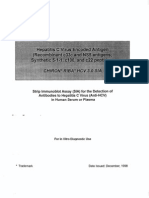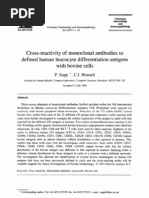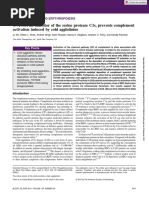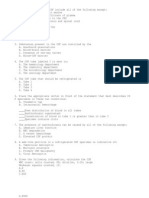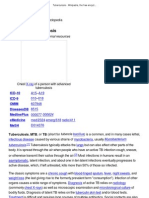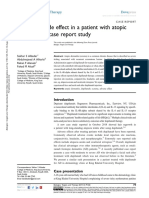PBMC Poster
PBMC Poster
Uploaded by
米許Copyright:
Available Formats
PBMC Poster
PBMC Poster
Uploaded by
米許Copyright
Available Formats
Share this document
Did you find this document useful?
Is this content inappropriate?
Copyright:
Available Formats
PBMC Poster
PBMC Poster
Uploaded by
米許Copyright:
Available Formats
HLA-Typed PBMC Samples with Established Antigen/Peptide Reactivity for Accelerating and Standardizing Human Immunological Research
WJ Zhang, C Shive, N Sigmund, OS Targoni, PV Lehmann Cellular Technology Ltd, Cleveland, OH, USA
Introduction
We have developed a protocol to cryopreserve human peripheral blood mononuclear cells (PBMC) while maintaining full functionality. The thawed PBMC displayed > 90% viability, and when tested for peptide or protein antigen-induced T cell recall responses in cytokine ELISPOT assays, the frequencies and per-cell cytokine productivities of the thawed cells approximated 100% of the fresh PBMC. Since serum is a highly variable reagent that affects the results, we also developed serum free freezing and testing media (CTL-Cryo, CTL-Test) towards standardization. Based on these developments, we are building an immune-characterized PBMC library of HLA-typed healthy human donors intended as positive and negative controls for T cell monitoring in ELISPOT, ELISA, cytokine bead array, tetramer/pentamer, and cytokine capture assays. Ready access to such PBMC should facilitate human immunological research and assay standardization within laboratories, and between different laboratories.
140 120 100
CD4CD8-
80 60 40 20 0
Medium Medium
FluFlu Mat1 58 58 Mat1
HCMV pp65 HCMV pp65 495 495
Candida Candida
Mumps Mumps
Fig 4. Defining recall antigen-induced responses as CD4 or CD8 cell mediated. PBMC were depleted of CD4 (blue) or CD8 (red) cells using magnetic beads, and the cell populations obtained for a donor were tested in an IFN- ELISPOT assay for the recall response to the antigens specified. The results show that CD8 cell depletion entirely abrogates the recall response to Flu Mat1 58 and the HCMV pp65 495 peptide but CD4 cell depletion does not affect the recall response identifying the cytokine-producing cells as CD8 cells. Candida and Mumps elicited recall responses by CD4 cells.
# of spots
Donor 1 Antigen Media HLA restriction A2, A3 B7,B44, Bw4, Bw6, C7 1 0 251 9.17 A1 A1 A2 A2 A2 A3 A3 A3 A11 A11 A24 AA68 B0702 B7 B8 B8 B8 B8 B27 B27 B35 B44 B44 1 1 1.3 0.58 62.7 9.07 21.7 7.21 0 0 9.7 2.08 4.3 2.08 2.3 1.15 7.7 4.16 0.3 0.58 1.7 1.15 36.7 5.51 3 1 48.3 14.64 2.3 2.31 9 13.86 0.7 1.15 1 1 0.7 0.58 1 1 2 1 62.7 12.58 1 0 280 7.55 66 14 33.3 19.66 46 11.53 30 13.11
Donor 2 A2, B18, B51, Bw4, Bw6, C2 0.3 0.58 352.7 13.32 0.3 0.58 0.7 0.58 6 1.53 53 11.37 42 2.94 26 4.58 3.7 3.79 8.7 3.06 0.3 0.58 0.3 0.58 0.3 0.58 2 1 3.3 0.58 8.3 2.52 0.3 0.58 1.3 1.53 2 1 1 1 0.7 1.15 19.7 4.62 0 0 0.3 0.58 7 1 78 11.93 77.3 26.1 6.3 9.29 7.7 4.73 3 1.73
Donor 3 A2 A11 B7,B35, Bw6, C4, C7 0 0 248.6 58.9 0.3 0.58 0.7 0.58 9.5 3.51 12.8 5.12 0.7 1.15 0.7 1.15 1.3 0.58 0 0 3 1 0.7 0.58 0.3 0.58 12.3 3.51 2.3 3.21 18 3.21 1.3 1.53 0.7 0.58 0.7 0.58 0.3 0.58 0 0 0.7 1.15 0 0 2.7 1.53 0.7 0.58 18.3 2.52 104.7 41.15 1.3 0.58 134.8 12.12 11.3 2.31
Results
Fresh PBMC Donor A Test antigen Media Mumps EBV BMLF1 259 Flu Mat1 58 B Media Flu Mat1 58 EBV EBNA3c 281 HCMV pp65 C Media Mumps EBV BMLF1 259 Flu NP 91 Mean 1.00 66.00 73.30 14.00 0.30 19.70 77.70 7.00 0.90 127.00 20.30 18.70 SD 0.00 14.00 9.07 7.21 0.50 10.02 12.58 1.00 0.78 11.15 3.51 3.51 Frozen PBMC Mean 0.30 66.70 62.70 18.30 0.00 16.50 62.70 6.50 0.70 127.30 15.00 18.50 SD 0.50 14.99 11.59 3.51 0.00 9.40 12.01 2.52 0.58 9.00 2.16 4.80 P value 0.07 0.96 0.28 0.41 0.36 0.71 0.21 0.77 0.74 0.97 0.09 0.96
CEF pool Flu PB 591
Table1. No statistically significant difference between the IFN- recall response of fresh and cryopreserved PBMC. Freshly isolated PBMC were tested in 24h IFN- ELISPOT assays at 200,000 cells per well, directly ex vivo (Fresh PBMC). The test antigens were 23 individual peptides from a library of 23 MHC-Class I restricted CEF peptides, in addition to the protein antigens Candida, Tetanus, Mumps, Dust Mite, and PPD. After the fresh PBMC had been plated for these assays, the remaining PBMC were cryopreserved in CTL-Cryo serum free freezing medium according to CTL protocols (Frozen PBMC). These cells were thawed, and were retested under identical conditions as the fresh PBMC, using the serum free testing medium CTLTest. Representative data are shown as the mean number of IFN- spots induced by the specified antigens for the fresh and the frozen PBMC of 3 donors. The P values on the right show that there is no statistical significant difference between the performance of fresh and frozen PBMC.
Flu NP 44 EBV BMLF1 259 Flu Mat1 58 HCMV pp65 495 Flu NP 265 EBV BRLF1 148 EBV EBNA3a 603 EBV EBNA3b 416 EBV BRLF1 134 EBV BRLF1 28 Flu NP 91 HCMV pp65 417 EBV EBNA3a 379 EBV EBNA3a 158 EBV EBNA3a 325 EBV BZLF1 190 FLU NP 380 EBV EBNA3c 258 FLU NP 383 EBV EBNA3a 458 EBV EBNA3c 281 HCMV pp65 Candida
Panel A
Subject ID 1 2 3 4 5 6 7 8 9 10 11 12 13 14 15 16 17 18 % Viable 95.3 91.4 91.3 91.5 95.3 95.0 93.2 91.3 95.0 93.3 94.6 87.0 89.8 86.7 92.1 92.6 95.4 95.6 % Recovery 80.8 80.6 87.1 92.7 98.3 82.6 94.8 80.5 99.6 94.7 96.2 97.2
Panel B Viable Dead
(95.3%) (4.7%)
Mumps Dust Mite Mix PPD Tetanus
Fig 5. Immune characterized cryopreserved PBMC library. The PBMC of each donor have been characterized for reactivity to a panel of 23 individual peptides (common viral Class I-restricted determinants) and 5 protein recall antigens, recognized by CD8 and CD4 cells, respectively. Up to 1,500 vials of each of the characterized samples have been cryopreserved. To date, samples from 21 donors have been frozen and characterized, continuing at the rate of 2 new donors per week.
Panel C
100.0 80.0
Percent
99.4 80.1 84.9 92.7 93.9 99.5
Implications:
- Ready access to PBMC: no need for IRB. - Experiments can be designed online based on established HLA-types and antigen reactivity. - Sizable donor pool facilitates screening for new reactivities and markers. - Unlimited cell numbers available for experimentation. - Continuous access to PBMC of the same donor and of the same bleed permit rapid progress with controlled experimentation. - Experiments can be readily repeated and extended, e.g. if reviewers ask for additional experiments. - Ability to share the same PBMC with colleagues anywhere helps collaborative work. - Assay comparisons and validations are facilitated by access to precharacterized reference samples. - Availability of positive and negative control samples, e.g., for clinical trials.
60.0 40.0 20.0 0.0
Viability
Recovery
Fig 2. Viability and recovery rate of cryopreserved PBMC. Cryopreserved PBMC of 18 donors were thawed according to CTL protocols. (A) The viability of the cells (number of viable cells/total number of cells x 100) was established by viable-dead cell staining using the Guava platform. Also shown are the recovery rates (cell number after thawing /number of cells frozen x 100). (B) A representative plot is shown. (C) The mean and standard deviation of viability and recovery rates for all 18 donors are shown.
50 45 40 35 30 25 20 15 10 5 0 -2.80
Panel A
80 70 60
Fresh Frozen
Panel B
50 40 30 20 10 0
-2.60
-2.40
-2.20
-2.00
-1.80
-1.60
-1.40
-1.20
-1.00
-3.00
-2.80
-2.60
-2.40
-2.20
-2.00
-1.80
-1.60
-1.40
Fig 3. Cryopreservation does not impair the cytokine productivity of individual CD4 or CD8 T cells. In cytokine ELISPOT assays, the spot size reflects the cytokine productivity of individual cells. We used an ImmunoSpot Series 3B Analyzer for the morphometric analysis of IFN- spots induced by antigens that trigger CD4 (Panel A) cells or CD8 (Panel B) cells. The spot size distribution for each category is shown for fresh (green) and frozen (blue) cells.
You might also like
- Rodak's Hematology 6th Edition Test BankDocument255 pagesRodak's Hematology 6th Edition Test Bankromerolourdes4100% (1)
- Marrow Transplanted Patients Inhibits Cell-Mediated Cytolysis A Soluble Factor Released by CD8+CD57+ Lymphocytes From BoneDocument6 pagesMarrow Transplanted Patients Inhibits Cell-Mediated Cytolysis A Soluble Factor Released by CD8+CD57+ Lymphocytes From Bonecyahayue5554No ratings yet
- HCV Riba ChironDocument25 pagesHCV Riba ChironPrasanth GovindanNo ratings yet
- ML7111 MCQs Answers March 2020Document15 pagesML7111 MCQs Answers March 2020Cleo SalvadorNo ratings yet
- Immuno-Monitoring of CD8+ T Cells in Whole Blood Versus PBMC SamplesDocument8 pagesImmuno-Monitoring of CD8+ T Cells in Whole Blood Versus PBMC SamplesastheniiaNo ratings yet
- OrthoDocument7 pagesOrthoankur GuptaNo ratings yet
- Serology 100 PT QuestionnaireDocument6 pagesSerology 100 PT QuestionnaireKate Camat FaminialagaoNo ratings yet
- Declaration of Traceability and Uncertainty For Myt-3D, Myt-5D and Myt-CALDocument1 pageDeclaration of Traceability and Uncertainty For Myt-3D, Myt-5D and Myt-CALAna-Maria CroitoruNo ratings yet
- 2016 ECCMID Poster CMV Validation ELITe IngeniusDocument1 page2016 ECCMID Poster CMV Validation ELITe IngeniusDVNo ratings yet
- Two-Step Negative Enrichment of CD4 and CD8 T Cells From Murine Spleen Via Nylon Wool Adherence and An Optimized Antibody CocktailDocument9 pagesTwo-Step Negative Enrichment of CD4 and CD8 T Cells From Murine Spleen Via Nylon Wool Adherence and An Optimized Antibody CocktailDr_UbaldoNo ratings yet
- Exam-1Document12 pagesExam-1hry8nzkggwNo ratings yet
- A Dual-Targeting, Apoptosis-Inducing Organometallic Half-Sandwich Iridium Anticancer ComplexDocument6 pagesA Dual-Targeting, Apoptosis-Inducing Organometallic Half-Sandwich Iridium Anticancer ComplexLuizaNo ratings yet
- Clinical Chemistry and Laboratory Medicine (CCLM) Analytical Performance of An Automated Volumetric Flow Cytometer For Quantitation of T B and NaturaDocument12 pagesClinical Chemistry and Laboratory Medicine (CCLM) Analytical Performance of An Automated Volumetric Flow Cytometer For Quantitation of T B and NaturaMARIANNE CASTILLO ESCOBARNo ratings yet
- Ijbsv 18 P 3470 S 1Document15 pagesIjbsv 18 P 3470 S 1李秀赫No ratings yet
- Pasq 2004 BloodDocument8 pagesPasq 2004 BloodlillareinigerNo ratings yet
- 1 s2.0 S0304383506002151 MainDocument9 pages1 s2.0 S0304383506002151 MainRuth RodríguezNo ratings yet
- Gene Therapy in Patients With The Crigler-Najjar Syndrome - AppendixDocument16 pagesGene Therapy in Patients With The Crigler-Najjar Syndrome - AppendixbbeeNo ratings yet
- Immunology - 2008 - Montcuquet - Regulatory T Cell Expansion and Function Do Not Account For The Impaired Alloreactivity ofDocument11 pagesImmunology - 2008 - Montcuquet - Regulatory T Cell Expansion and Function Do Not Account For The Impaired Alloreactivity ofciara babyNo ratings yet
- Recall 1Document4 pagesRecall 1pikachuNo ratings yet
- Cross-Reactivity of Monoclonal Antibodies To Defined Human Leucocyte Differentiation Antigens With Bovine CellsDocument15 pagesCross-Reactivity of Monoclonal Antibodies To Defined Human Leucocyte Differentiation Antigens With Bovine CellsFrank D. KolodgieNo ratings yet
- Paper ELISA FullDocument4 pagesPaper ELISA FullAle GodoyNo ratings yet
- CKMBDocument8 pagesCKMBSinari AlfatNo ratings yet
- Letters: Isolation of Rare Circulating Tumour Cells in Cancer Patients by Microchip TechnologyDocument8 pagesLetters: Isolation of Rare Circulating Tumour Cells in Cancer Patients by Microchip TechnologyFebrina ViselitaNo ratings yet
- Keystone PosterDocument1 pageKeystone PosterSaswati Chakraborty MisraNo ratings yet
- Registration File of HCV Rapid Test (Serum/Plasma)Document46 pagesRegistration File of HCV Rapid Test (Serum/Plasma)Кристина ПаскальNo ratings yet
- Cerebrospinal Fluid: Practice Test SheetDocument7 pagesCerebrospinal Fluid: Practice Test SheetJoey MagnoNo ratings yet
- CTLA4 Is A Second Receptor For The B Cell Activation Antigen B7Document9 pagesCTLA4 Is A Second Receptor For The B Cell Activation Antigen B7Fernanda RibeiroNo ratings yet
- Plenary PaperDocument8 pagesPlenary PaperYaseen MohamnadNo ratings yet
- Laboratory Procedure Manual: Cd4+ T-Lymphocytes and Cd8 T Cells Whole Blood Tricount MethodDocument11 pagesLaboratory Procedure Manual: Cd4+ T-Lymphocytes and Cd8 T Cells Whole Blood Tricount MethodanggaririnNo ratings yet
- Biological Database SpecificationDocument7 pagesBiological Database SpecificationmilossmileNo ratings yet
- C-Peptide: Diagnostic Automation, IncDocument6 pagesC-Peptide: Diagnostic Automation, IncmusiboyinaNo ratings yet
- Chapter 18 Path and Lab Set BDocument4 pagesChapter 18 Path and Lab Set BBernard Paul Guinto0% (1)
- Albumina 1Document2 pagesAlbumina 1Vale FrancoNo ratings yet
- Analysis of CD16þCD56dim NK Cells From CLL Patients Evidence Supporting ADocument9 pagesAnalysis of CD16þCD56dim NK Cells From CLL Patients Evidence Supporting Aimmunologie cellulaireNo ratings yet
- Variant II Turbo Substantial Equivalence DeterminationDocument8 pagesVariant II Turbo Substantial Equivalence DeterminationMeesam AliNo ratings yet
- Apoptosis PlaybookDocument20 pagesApoptosis PlaybookArmando SignoreNo ratings yet
- Practice Exam2013Document8 pagesPractice Exam2013Elizabeth LeeNo ratings yet
- Citosol (Thiamylal Sodium) Triggers Apoptosis and Affects Gene Expressions of Murine Leukemia RAW 264.7 Cells - RS-C Wu, C-S YuDocument1 pageCitosol (Thiamylal Sodium) Triggers Apoptosis and Affects Gene Expressions of Murine Leukemia RAW 264.7 Cells - RS-C Wu, C-S YuAlondra MaldonadoNo ratings yet
- Cystatin C As A Marker of GFR-History, Indications, and Future ResearchDocument8 pagesCystatin C As A Marker of GFR-History, Indications, and Future ResearchMaya RustamNo ratings yet
- Baseline Tumor Growth MiceDocument3 pagesBaseline Tumor Growth MiceDanik BalahonovNo ratings yet
- Lab Specimen and Microscopy - Study Guide-3Document26 pagesLab Specimen and Microscopy - Study Guide-3alphaceta100% (1)
- MLT 1040 Unit 3 QuestionsDocument13 pagesMLT 1040 Unit 3 Questionstomsim_alsoNo ratings yet
- (SICI)1521-4141(199904)29_041406__AID-IMMU14063.0.CODocument12 pages(SICI)1521-4141(199904)29_041406__AID-IMMU14063.0.COengpath2024No ratings yet
- Republic of The Philippinescc1Document22 pagesRepublic of The Philippinescc1Go IdeasNo ratings yet
- Bio Protocol689 SpleenDocument4 pagesBio Protocol689 SpleenBagus Muhammad IhsanNo ratings yet
- Flow User's GuideDocument25 pagesFlow User's Guidemdek57No ratings yet
- Gpc3 Generate de Celule Dendritice 2010Document11 pagesGpc3 Generate de Celule Dendritice 2010grigmihNo ratings yet
- Blood Bank Comprehensive Review NotesDocument34 pagesBlood Bank Comprehensive Review Notesryannn shaannneNo ratings yet
- Antimicrob. Agents Chemother. 1988 Shelton 268 70Document4 pagesAntimicrob. Agents Chemother. 1988 Shelton 268 70Engr Syed Bilal AliNo ratings yet
- 019-Chapter 18 CREB Regulated Transcription Coactivator 1 (CRTC1) Interacts with MicrotubulesDocument6 pages019-Chapter 18 CREB Regulated Transcription Coactivator 1 (CRTC1) Interacts with MicrotubulesNiisamaNo ratings yet
- s10895 018 2306 4Document12 pagess10895 018 2306 4amlmahmoudgad124No ratings yet
- Kanaoka 1999Document6 pagesKanaoka 1999awdafeagega2r3No ratings yet
- Moh ExamDocument12 pagesMoh Exambsmls-f18-017No ratings yet
- Hemapheresis: Sandhya R. Panch and Harvey G. KleinDocument11 pagesHemapheresis: Sandhya R. Panch and Harvey G. KleinNur Melani Sari WardaniNo ratings yet
- IPP-LB-HEM-01-01-LH 750 Analyzer and Coulter Gen's SystemDocument13 pagesIPP-LB-HEM-01-01-LH 750 Analyzer and Coulter Gen's SystemMaria Francesca MapaNo ratings yet
- Hematology - 2013 SDDDocument17 pagesHematology - 2013 SDDOrlan Defensor BalanoNo ratings yet
- Bioprocessing Technology for Production of Biopharmaceuticals and BioproductsFrom EverandBioprocessing Technology for Production of Biopharmaceuticals and BioproductsClaire KomivesNo ratings yet
- Bioprocessing for Cell-Based TherapiesFrom EverandBioprocessing for Cell-Based TherapiesChe J. ConnonNo ratings yet
- Biology BDocument12 pagesBiology Bspiyush.ranjansahooNo ratings yet
- Inserto 038032 Virus Hepatitis B HBV 260Document2 pagesInserto 038032 Virus Hepatitis B HBV 260labdicosaNo ratings yet
- Muhammad Asif Zeb Lecturer Hematology Ipms-KmuDocument21 pagesMuhammad Asif Zeb Lecturer Hematology Ipms-KmuHanif ullahNo ratings yet
- Antibiotics Currently in Development April 2020Document36 pagesAntibiotics Currently in Development April 2020tanishtarun06No ratings yet
- Appendix 2. Interpretation of Xpert Assay Results - MSF Medical GuidelinesDocument7 pagesAppendix 2. Interpretation of Xpert Assay Results - MSF Medical GuidelinesJemal seidNo ratings yet
- Dengue, CIA and PakistanDocument17 pagesDengue, CIA and Pakistanسید ہارون حیدر گیلانی100% (1)
- The Tamilnadu Dr. M.G.R. Medical University: Dissertation Submitted ToDocument75 pagesThe Tamilnadu Dr. M.G.R. Medical University: Dissertation Submitted Tosangam singhNo ratings yet
- Icha 1Document5 pagesIcha 1kadek ayu ichaNo ratings yet
- CandidiasisDocument27 pagesCandidiasisBhavesh SippyNo ratings yet
- WOC Steven Johnson Syndrome TranslateDocument1 pageWOC Steven Johnson Syndrome TranslateFebry Rolando NainggolanNo ratings yet
- Warta Kerajaan Persekutuan: Federal Government GazetteDocument3 pagesWarta Kerajaan Persekutuan: Federal Government GazetteAswadi MohamadNo ratings yet
- By: Amit Chandanshive F.Y.M.PHARM.: Guide: Mrs. Vijaya BhogaleDocument39 pagesBy: Amit Chandanshive F.Y.M.PHARM.: Guide: Mrs. Vijaya Bhogaleirfan fadilahNo ratings yet
- Food Borne Diseases - PPT UpdatedDocument31 pagesFood Borne Diseases - PPT UpdatedHephzibah Okyere - MensahNo ratings yet
- Dengue FeverDocument38 pagesDengue FeverAahila NoorNo ratings yet
- Carestia 2015Document10 pagesCarestia 2015Ricardo GomezNo ratings yet
- Organization and Expression of Ig GenesDocument54 pagesOrganization and Expression of Ig GenesViswa TejaNo ratings yet
- Emqs For Medical Students: Second EditionDocument26 pagesEmqs For Medical Students: Second EditionAnonymous ud8gDeN50% (2)
- 8 Reasons I Havent Vaccinated My ChildDocument4 pages8 Reasons I Havent Vaccinated My ChildMichael SmithNo ratings yet
- Immune MonitoringDocument6 pagesImmune MonitoringcandiddreamsNo ratings yet
- Laporan Reagen 2019 - 2020Document20 pagesLaporan Reagen 2019 - 2020Amie zulaikaNo ratings yet
- Review of Related LiteratureDocument11 pagesReview of Related LiteratureLunel John RuazaNo ratings yet
- Candidiasis - Causes, Symptoms, Treatment, DiagnosisDocument5 pagesCandidiasis - Causes, Symptoms, Treatment, DiagnosisChaiwa JustineNo ratings yet
- TonsilitisDocument23 pagesTonsilitisatai-phin-4632100% (4)
- Tuberculosis - Wikipedia, The Free EncyclopediaDocument15 pagesTuberculosis - Wikipedia, The Free EncyclopediaitsmepranielNo ratings yet
- Blood TransfusionDocument31 pagesBlood TransfusionMilagros Florita100% (1)
- 4.immunohistochemistry INTRODocument25 pages4.immunohistochemistry INTROCZAVIOUR WAFUMBONo ratings yet
- 1 Septicemia, & SepsisDocument14 pages1 Septicemia, & SepsisfgrNo ratings yet
- Dupilumab Side Effect in A Patient With Atopic Dermatitis: A Case Report StudyDocument4 pagesDupilumab Side Effect in A Patient With Atopic Dermatitis: A Case Report StudyKihyun YooNo ratings yet
- Streptokokni Toksični Šok SindromDocument6 pagesStreptokokni Toksični Šok SindromNandor SiliNo ratings yet
- Biomedical Science 2nd Year Immunology Course IntroductionDocument28 pagesBiomedical Science 2nd Year Immunology Course IntroductionWazzaapXDNo ratings yet


